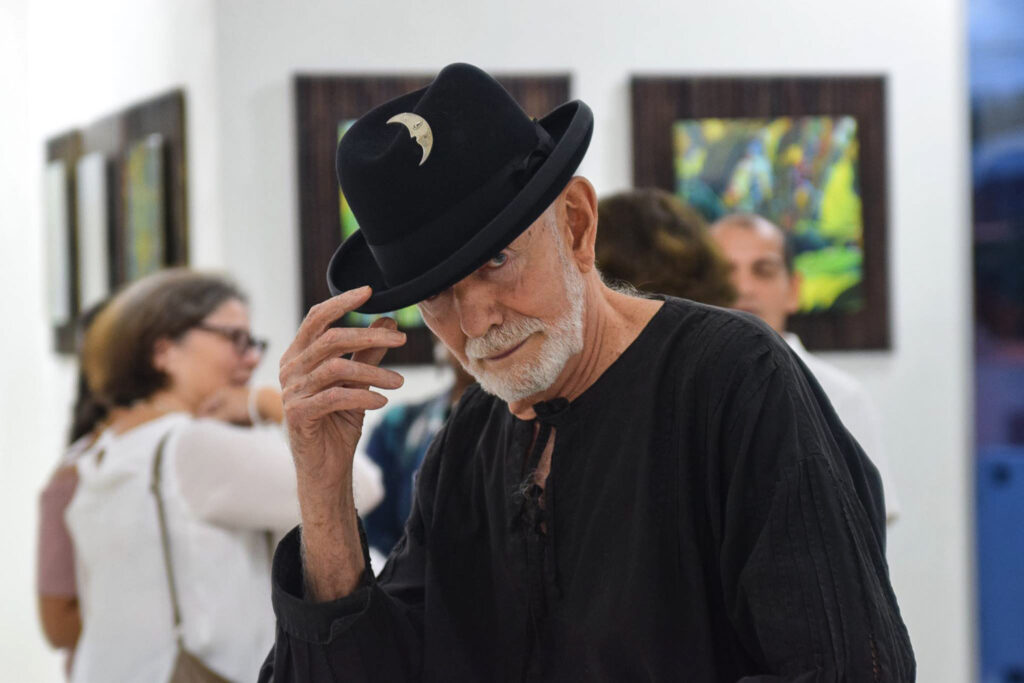Mask: The Kiss of the Sun and the Moon
Peter Minshall
Undated (1990-2012)
21 x 21″
Acrylic on wire and papier-mâché
Peter Minshall
Undated (1990-2012)
21 x 21″
Acrylic on wire and papier-mâché
Peter Minshall
Undated (1993)
24 x 24″
Acrylic on paper
Peter Minshall
Undated (1991
10.75 x 26″
Acrylic on paper, cut out and collaged
Born in Georgetown, Guyana, Minshall moved to Trinidad as a small child and was exposed to Carnival very early on. He made his first costume at 13 years old. He attended Queen’s Royal College, then went on to study Theatre Design at the Central School of Art and Design in London. His first major theatrical commission, for a production at Sadler’s Wells, came after a director saw a portfolio of his Carnival designs. The costume”From the Land of the Hummingbird” which he created for his adopted sister Sherry-Ann Guy (Coelho) in 1974 was one of his many iconic designs and was a pivotal in his journey. It took five weeks, 12 people, 104 feathers, each one made of 150 different pieces of fabric to bring it to life.
The following year, Minshall designed a band for London’s Notting Hill Carnival, and in 1976 he was asked by veteran bandleaders Stephen and Elsie Lee Heung to design a full-size band for Trinidad Carnival. Minshall chose the theme Paradise Lost, which was inspired by Milton’s epic poem. This was followed by the bands Zodiac (1978), Carnival of the Sea (1979), Dance Macabre (1980), and Jungle Fever (1981). Papillon (1982), which consisted of 2,500 masqueraders wearing ten-foot butterfly wings in a huge meditation on the ephemeral nature of life, was another Minshall landmark. River (1983) began the trilogy of bands that many consider Minshall’s magnum opus. The queen of the band, “Washerwoman”, represented life and purity; the king, “Mancrab”, was a symbol of greed and technological madness.
The River trilogy continued in 1984 with Callaloo and concluded in 1985 with The Golden Calabash, in which two full-size bands, Princes of Darkness and Lords of Light, clashed in an epic symbolic battle between good and evil.
“Tan Tan” and “Saga Boy”, are among Minshall’s most iconic creations, notably for there larger than life presence and unbelievably life like mechanics.
Minshall’s began his second trilogy in 1995 with a band he called Hallelujah, and continued with Song of the Earth (1996) and Tapestry (1997).
Minshall produced a series of sardonic bands in the late 1990s and early 2000s– The Lost Tribe (1999), This Is Hell (2001), Ship of Fools (2003)–relieved only by his joyful Picoplat (2002), a band of colourful dancing birds.
Minshall claims that mas—”living art that we make fresh every year”—is the truest artistic expression of Trinidad.
In addition to designing mas, Minshall has worked on a variety of performance projects. In 1985, he led Adoration of Hiroshima, a nuclear protest mas’, in Washington, D.C. He helped design the opening ceremonies for the 1987 Pan American Games in Indianapolis, the Barcelona 1992 Summer Olympics, the Atlanta 1996 Summer Olympics, the 1994 Football World Cup and the Salt Lake 2002 Winter Olympics.
His exhibition at Y Art Gallery, Minshall Miscellany, in 2012, provided “a rich sampling of variety… but… there was is a complex web of interrelatedness.” -Todd Gulick, including works like Rainbow for Everyman and Jouvay: the Rising Sun.
